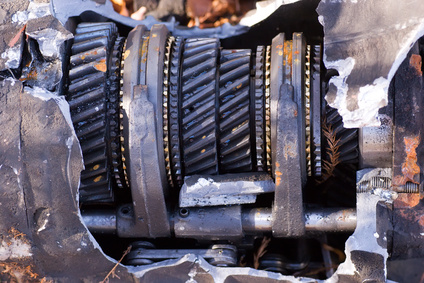
The automatic gearbox, also known as the automatic transmission, can experience various operational problems over time. The gearbox transmits engine power (torque) to the rear wheels through a series of graduated gears, doing so smoothly and with perfect synchronization. The transmission fluid functions as the liquid power source that switches and drives the gears under pressure while keeping the interior parts lubricated and cool. There are some warning signs to look out for when the automatic gearbox begins to fail.
The most common reason for automatic gearbox slippage, overheating or non-operation will be inadequate transmission fluid in the system. If the transmission fluid gets too low, the remaining fluid cannot be picked up by the pump and circulated through the system. Less fluid translates to reduced temperature control, which leads to overheating and transmission fluid that will lose its viscosity (thickness). Major gearbox slippage can result.
Automatic gearboxes have a filter screen device located in the main pan. The filter traps all metal shavings and foreign debris and keeps them from entering the delicate channels and passages in the gearbox valve body. Dirty or contaminated gearbox fluid will not have a clean red color, but look muddy or yellow. Dirty fluid can also "froth up" and resemble the consistency of a milkshake, both in color and feel. This condition allows too much air into the channels which will keep the pump from maintaining an equalized pressure. Burnt fluid will have a smoky or acrid smell, and results from old, dirty or contaminated fluid. Checking the fluid at the dipstick can alert the vehicle owner to this problem.
Vehicles equipped with vacuum control modules on the side of the gearbox have a vacuum line that runs from the engine to the gearbox. The strength of the vacuum determines when the gears will shift at the proper speed. If the vacuum line leaks, it can force the gears to shift at a too high or low RPM. If the vacuum line has become disconnected, the gearbox might not shift at all. The line and connection should be in good condition and tight at the fitting.
The gearbox will leak mostly from external sources since its design is a closed system. Leaks can be found at the dipstick filler tube base, at the gearbox drain plug, at the linkage connection with the gearbox, at the speed sensor or cable, or at the gearbox cooling lines that enter the bottom of the radiator. If the input or output gearbox shaft seals have worn, there will be a leak at the end of the gearbox tail shaft (near the front drive-line U-joint) or at the bottom of the bell housing. All leaks should be tracked down and repaired.
The gearbox shift linkage consists of levers and rods that shift the various drive positions, activated by the manual shifter lever in the vehicle. Disconnected or bent linkage levers and arms will keep the shift selector from choosing the proper gear, such as park, reverse or drive. Linkage connections should be checked for tightness at the points where they join the gearbox levers.
The gearbox has bands and clutches inside that engage each gear, beginning with first gear and up to the highest gear. The bands function just like a pressure plate on a manual gearbox, and the clutches operate (grab) just like a manual clutch. An automatic gearbox might slip in one or two gears only yet function normally with the others. This sign points to worn clutch material or weak bands inside the automatic gearbox. This condition can only be repaired by a professional transmission service shop.